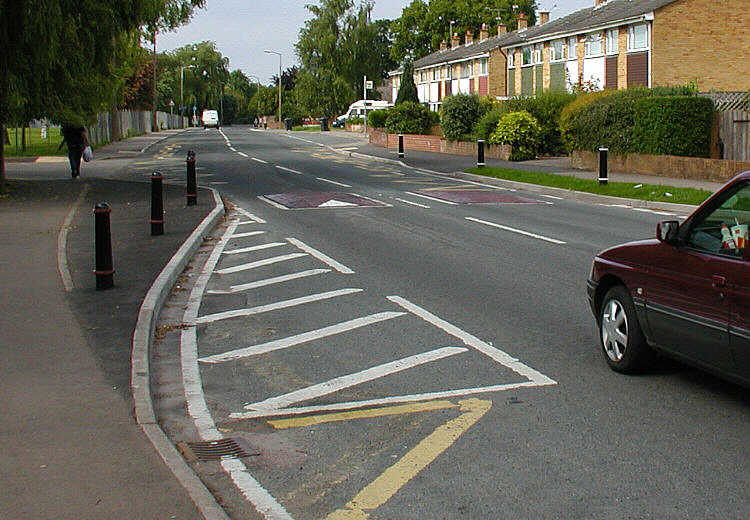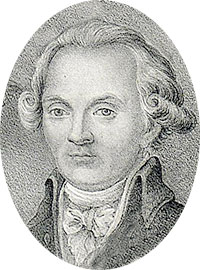|
2-1 Road
A 2-1 road (2-minus-1 road) is a type of road with extra wide shoulders, and a smaller single two-way lane in the middle for vehicles. The shoulders are to be used by pedestrians and cyclists, and if necessary by meeting vehicles. The purpose of the road is to give more space to pedestrians and cyclists and thereby avoid constructing new dedicated pedestrian and bicycle paths, especially in areas where new constructions are to be avoided or not possible. The road-type is popular in Denmark where a third of all municipalities have at least one stretch of this type of road. Together with other traffic calming measures these roads have lowered traffic accidents with about 25%. Sweden started building this type of road in 2006 and is there called ''"bymiljöväg",'' or in English ''"village environment road"'', as it often goes through and between different dispersed settlements. There the roads have been met by critique from both residents and the police as they believe it will lea ... [...More Info...] [...Related Items...] OR: [Wikipedia] [Google] [Baidu] |
Shoulder (road)
A shoulder, hard shoulder (British) or breakdown lane, is an emergency stopping lane by the verge of a road or motorway, on the right side in countries which drive on the right, and on the left side in countries which drive on the left. Many wider (U.S.) freeways, or expressways elsewhere have shoulders on both sides of each directional carriageway — in the median, as well as at the outer edges of the road, for additional safety. Shoulders are not intended for use by through traffic, although there are exceptions. Purpose Shoulders have multiple uses, including: * Emergency vehicles such as ambulances, fire trucks and police cars may use the shoulder to bypass traffic congestion. * In the event of an emergency or breakdown, a motorist can pull into the shoulder to get out of the flow of traffic and obtain a greater degree of safety. * Active traffic management, used on busy multi-lane roads, may allow 'hard shoulder running' by general traffic at reduced speeds during periods ... [...More Info...] [...Related Items...] OR: [Wikipedia] [Google] [Baidu] |
Two-way Street
A two-way street is a street that allows vehicles to travel in both directions. On most two-way streets, especially main streets, a line is painted down the middle of the road to remind drivers to stay on their side of the road. Sometimes one portion of a street is two-way and the other portion is one-way. If there is no line, a car must stay on the appropriate side and watch for cars coming in the opposite direction and prepare to pull over to let them pass. See also * Dual carriageway * One-way traffic One-way traffic (or uni-directional traffic) is traffic that moves in a single direction. A one-way street is a street either facilitating only one-way traffic, or designed to direct vehicles to move in one direction. One-way streets typical ... References * {{road-stub Types of roads ... [...More Info...] [...Related Items...] OR: [Wikipedia] [Google] [Baidu] |
Denmark
) , song = ( en, "King Christian stood by the lofty mast") , song_type = National and royal anthem , image_map = EU-Denmark.svg , map_caption = , subdivision_type = Sovereign state , subdivision_name = Danish Realm, Kingdom of Denmark , established_title = History of Denmark#Middle ages, Consolidation , established_date = 8th century , established_title2 = Christianization , established_date2 = 965 , established_title3 = , established_date3 = 5 June 1849 , established_title4 = Faroese home rule , established_date4 = 24 March 1948 , established_title5 = European Economic Community, EEC 1973 enlargement of the European Communities, accession , established_date5 = 1 January 1973 , established_title6 = Greenlandic home rule , established_date6 = 1 May 1979 , official_languages = Danish language, Danish , languages_type = Regional languages , languages_sub = yes , languages = German language, GermanGerman is recognised as a protected minority language in t ... [...More Info...] [...Related Items...] OR: [Wikipedia] [Google] [Baidu] |
Municipality
A municipality is usually a single administrative division having corporate status and powers of self-government or jurisdiction as granted by national and regional laws to which it is subordinate. The term ''municipality'' may also mean the governing body of a given municipality. A municipality is a general-purpose administrative subdivision, as opposed to a special-purpose district. The term is derived from French and Latin . The English word ''municipality'' derives from the Latin social contract (derived from a word meaning "duty holders"), referring to the Latin communities that supplied Rome with troops in exchange for their own incorporation into the Roman state (granting Roman citizenship to the inhabitants) while permitting the communities to retain their own local governments (a limited autonomy). A municipality can be any political jurisdiction, from a sovereign state such as the Principality of Monaco, to a small village such as West Hampton Dunes, New York. Th ... [...More Info...] [...Related Items...] OR: [Wikipedia] [Google] [Baidu] |
Traffic Calming
Traffic calming uses physical design and other measures to improve safety for motorists, pedestrians and bicycle-friendly, cyclists. It has become a tool to combat speeding and other unsafe behaviours of drivers in the neighbourhoods. It aims to encourage safer, more responsible driving and potentially reduce traffic flow. Urban planners and Traffic engineering (transportation), traffic engineers have many strategies for traffic calming, including narrowed roads and speed humps. Such measures are common in Australia and Europe (especially Northern Europe), but less so in North America. Traffic calming is a calque (literal translation) of the German word ''Verkehrsberuhigung'' – the term's first published use in English was in 1985 by Carmen Hass-Klau. History In its early development in the UK in the 1930s, traffic calming was based on the idea that residential areas should be protected from through-traffic. Subsequently, it became valued for its ability to improve pedest ... [...More Info...] [...Related Items...] OR: [Wikipedia] [Google] [Baidu] |
English Language
English is a West Germanic language of the Indo-European language family, with its earliest forms spoken by the inhabitants of early medieval England. It is named after the Angles, one of the ancient Germanic peoples that migrated to the island of Great Britain. Existing on a dialect continuum with Scots, and then closest related to the Low Saxon and Frisian languages, English is genealogically West Germanic. However, its vocabulary is also distinctively influenced by dialects of France (about 29% of Modern English words) and Latin (also about 29%), plus some grammar and a small amount of core vocabulary influenced by Old Norse (a North Germanic language). Speakers of English are called Anglophones. The earliest forms of English, collectively known as Old English, evolved from a group of West Germanic (Ingvaeonic) dialects brought to Great Britain by Anglo-Saxon settlers in the 5th century and further mutated by Norse-speaking Viking settlers starting in the 8th and 9th ... [...More Info...] [...Related Items...] OR: [Wikipedia] [Google] [Baidu] |
Dispersed Settlement
A dispersed settlement, also known as a scattered settlement, is one of the main types of settlement patterns used by landscape historians to classify rural settlements found in England and other parts of the world. Typically, there are a number of separate farmsteads scattered throughout the area. A dispersed settlement contrasts with a nucleated village. It can be known as main human settlements. The French term ''bocage'' is sometimes used to describe the type of landscape found where dispersed settlements are common. In addition to Western Europe, dispersed patterns of settlement are found in parts of Papua New Guinea, as among the Gainj, Ankave, and Baining tribes. It is also frequently met with in nomadic pastoral societies. In Ghana, Kumbyili in the northern region is also an example of a dispersed settlement England In England, dispersed settlements are often found in the areas of ancient enclosure outside the central region—for example, Essex, Kent and the West Cou ... [...More Info...] [...Related Items...] OR: [Wikipedia] [Google] [Baidu] |
Swedish Police Authority
The Swedish Police Authority ( sv, Polismyndigheten) is the national police force (''Polisen'') of the Kingdom of Sweden. The first modern police force in Sweden was established in the mid-19th century, and the police remained in effect under local government control up until 1965, when it was nationalized and became increasingly centralized, to finally organize under one authority January 1, 2015. Concurrent with this change, the Swedish Security Service formed its own agency. The new authority was created to address shortcomings in the division of duties and responsibilities, and to make it easier for the Government to demand greater accountability. The agency is organized into seven police regions and eight national departments. It is one of the largest government agencies in Sweden, with more than 28,500 employees, of which police officers accounted for approximately 75 percent of the personnel in 2014. It takes two and a half years to become a police officer in Sweden, includi ... [...More Info...] [...Related Items...] OR: [Wikipedia] [Google] [Baidu] |
2+1 Road
2+1 road is a specific category of three-lane road, consisting of two lanes in one direction and one lane in the other, alternating every few kilometres, and usually separated with a steel cable barrier. The second lane allows faster-moving traffic to overtake slower vehicles at regular intervals. Traditional roads of at least width can be converted to 2+1 roads and reach near-motorway safety levels at a much lower cost than an actual conversion to motorway or dual carriageway. Sometimes, during freeway reconstruction, a barrier transfer machine will be used on one half of the freeway while the other is being reconstructed. A similar concept is utilized with 3-lane setups where 2 lanes have right of way, and the opposing side has to yield to the oncoming side on major highways that are mostly 2 lanes, of which those are more common. By country Estonia The construction of 2+1 roads in Estonia first started in autumn 2016, when a contract for a reconstruction of a 9 kilometr ... [...More Info...] [...Related Items...] OR: [Wikipedia] [Google] [Baidu] |
Road Diet
A road diet, also called a lane reduction, road rechannelization, or road conversion is a technique in transportation planning whereby the number of travel lanes and/or effective width of the road is reduced in order to achieve systemic improvements. Techniques A typical road diet technique is to reduce the number of lanes on a roadway cross-section. One of the most common applications of a road diet is to improve safety or provide space for other modes of travel. For example, a two-way, four lane road might be reduced to one travel lane in each direction. The freed-up space is then used to provide or enhance some of the following features: *Adding or widening of footpaths/sidewalks *Adding or widening of boulevards (landscaping strips) *Adding cycle lanes on one or both sides of the road *Adding reserved tramtracks, usually in the middle of the road *Widening remaining traffic lanes (if previously unsafely narrow to allow four lanes) *Adding a center turn lane / flush traffic ... [...More Info...] [...Related Items...] OR: [Wikipedia] [Google] [Baidu] |






